MSI Z87I Review: Mini-ITX Haswell for $140
by Ian Cutress on August 27, 2013 10:15 AM EST- Posted in
- Motherboards
- MSI
- Mini ITX
- Z87
Computation Benchmarks
Readers of our motherboard review section will have noted the trend in modern motherboards to implement a form of MultiCore Enhancement / Acceleration / Turbo (read our report here) on their motherboards. This does several things – better benchmark results at stock settings (not entirely needed if overclocking is an end-user goal), at the expense of heat and temperature, but also gives in essence an automatic overclock which may be against what the user wants. Our testing methodology is ‘out-of-the-box’, with the latest public BIOS installed and XMP enabled, and thus subject to the whims of this feature. It is ultimately up to the motherboard manufacturer to take this risk – and manufacturers taking risks in the setup is something they do on every product (think C-state settings, USB priority, DPC Latency / monitoring priority, memory subtimings at JEDEC). Processor speed change is part of that risk which is clearly visible, and ultimately if no overclocking is planned, some motherboards will affect how fast that shiny new processor goes and can be an important factor in the purchase. Processors which were tested on MultiCore Turbo enabled systems are indicated with a '+' symbol in the graphs.
For reference, the Z87I does have this feature enabled by default, although performance in some benchmarks is not what we would expect in this configuration.
Point Calculations - 3D Movement Algorithm Test
The algorithms in 3DPM employ both uniform random number generation or normal distribution random number generation, and vary in various amounts of trigonometric operations, conditional statements, generation and rejection, fused operations, etc. The benchmark runs through six algorithms for a specified number of particles and steps, and calculates the speed of each algorithm, then sums them all for a final score. This is an example of a real world situation that a computational scientist may find themselves in, rather than a pure synthetic benchmark. The benchmark is also parallel between particles simulated, and we test the single thread performance as well as the multi-threaded performance.
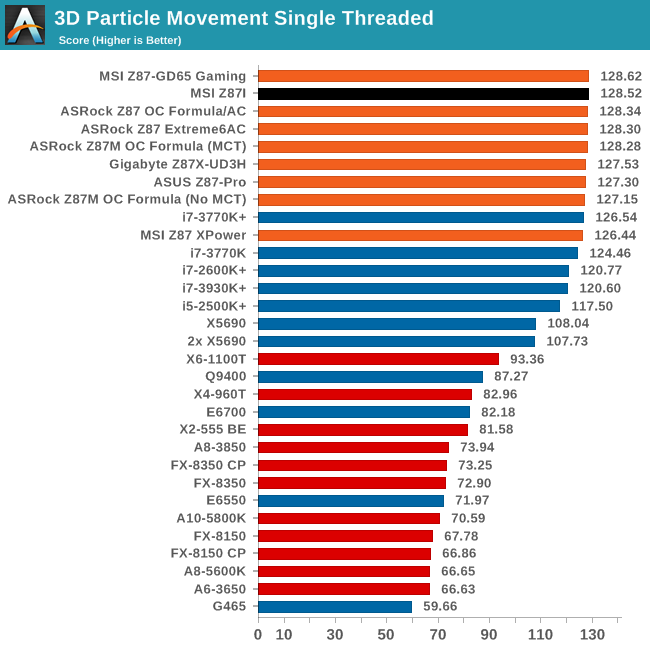
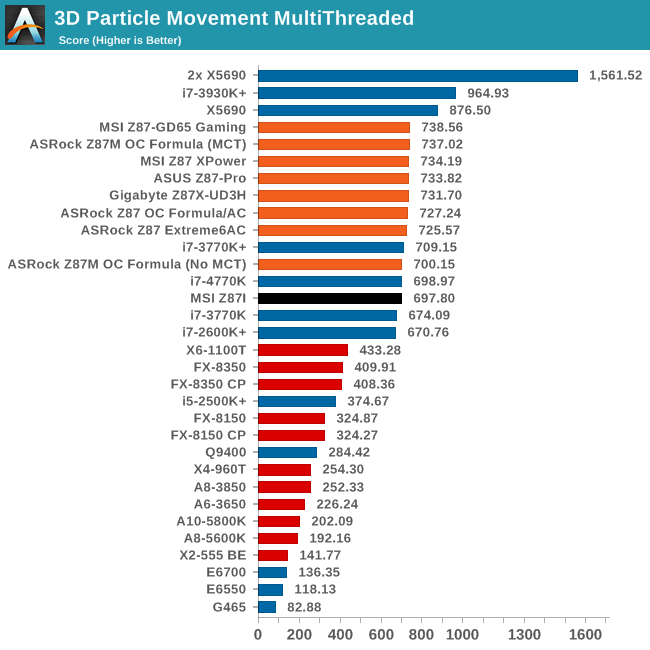
The MSI Z87I performs as expected in the single threaded test, however in the multi-threaded test we get a score around 700, rather than the 730+ we normally see with MultiCore Turbo enabled. In fact, despite the system (and CPU-Z) recognizing the full 3.9 GHz implementation, the benchmark performs similar to a non-MCT implementation.
Compression - WinRAR 4.2
With 64-bit WinRAR, we compress the set of files used in the USB speed tests. WinRAR x64 3.93 attempts to use multithreading when possible, and provides as a good test for when a system has variable threaded load. WinRAR 4.2 does this a lot better! If a system has multiple speeds to invoke at different loading, the switching between those speeds will determine how well the system will do.
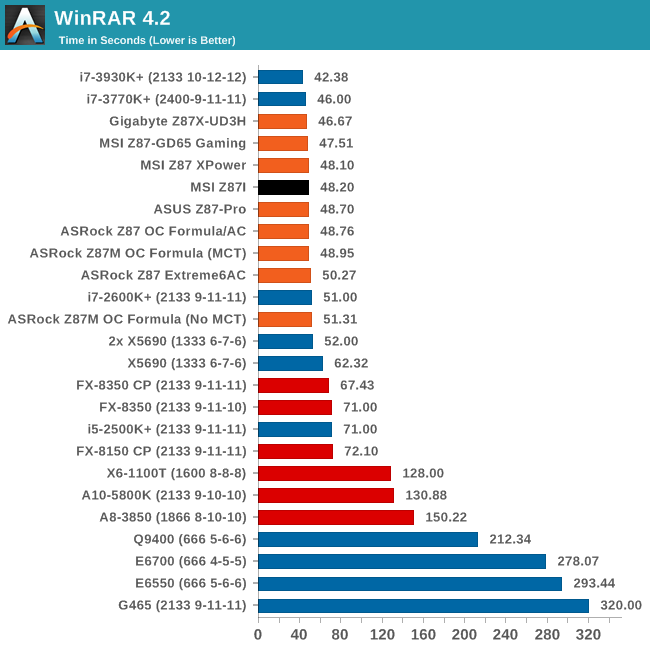
Despite the 3DPM-MT tests, the MSI Z87I is on par with WinRAR.
Image Manipulation - FastStone Image Viewer 4.2
FastStone Image Viewer is a free piece of software I have been using for quite a few years now. It allows quick viewing of flat images, as well as resizing, changing color depth, adding simple text or simple filters. It also has a bulk image conversion tool, which we use here. The software currently operates only in single-thread mode, which should change in later versions of the software. For this test, we convert a series of 170 files, of various resolutions, dimensions and types (of a total size of 163MB), all to the .gif format of 640x480 dimensions.
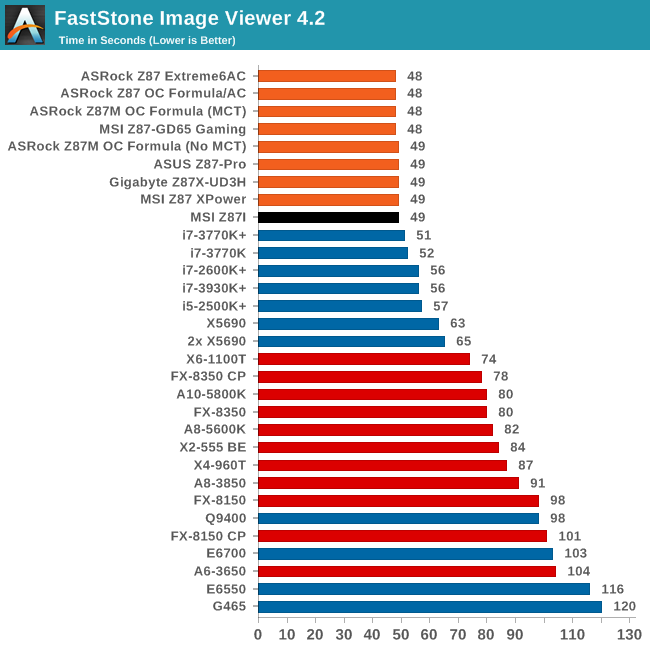
Being single threaded, the Z87I performs similarly to other boards for FastStone.
Video Conversion - Xilisoft Video Converter 7
With XVC, users can convert any type of normal video to any compatible format for smartphones, tablets and other devices. By default, it uses all available threads on the system, and in the presence of appropriate graphics cards, can utilize CUDA for NVIDIA GPUs as well as AMD WinAPP for AMD GPUs. For this test, we use a set of 33 HD videos, each lasting 30 seconds, and convert them from 1080p to an iPod H.264 video format using just the CPU. The time taken to convert these videos gives us our result.
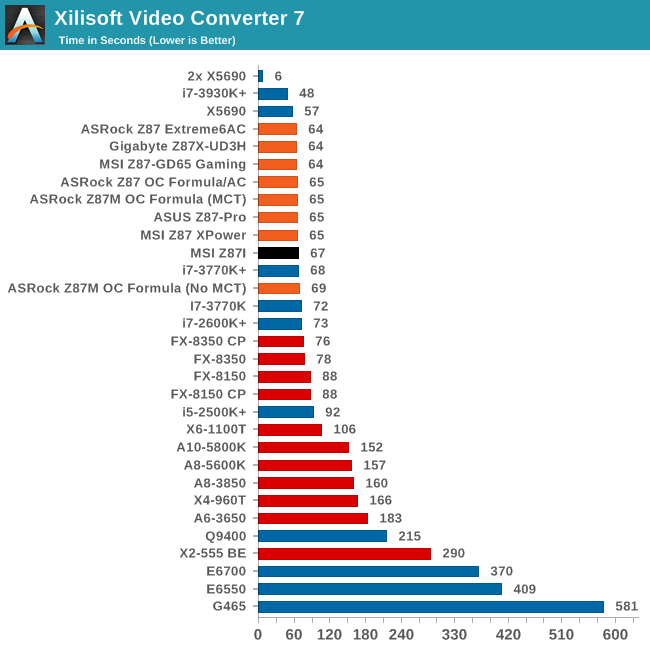
The Z87I fits in the middle between the non-MCT result and the other motherboards that have MCT, suggesting a continuance of the MCT issues observed.
Rendering – PovRay 3.7
The Persistence of Vision RayTracer, or PovRay, is a freeware package for as the name suggests, ray tracing. It is a pure renderer, rather than modeling software, but the latest beta version contains a handy benchmark for stressing all processing threads on a platform. We have been using this test in motherboard reviews to test memory stability at various CPU speeds to good effect – if it passes the test, the IMC in the CPU is stable for a given CPU speed. As a CPU test, it runs for approximately 2-3 minutes on high end platforms.
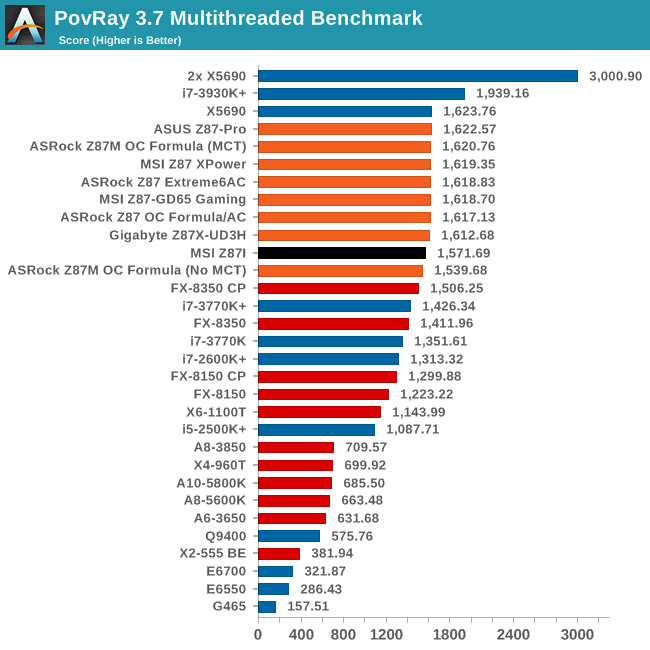
PovRay is particularly good at finding out if a benchmark is always at a constant speed on all tests, and in this case our results on the Z87I match what we saw with XVC – somewhere between the other MCT enabled motherboards and our non-MCT result.
Video Conversion - x264 HD Benchmark
The x264 HD Benchmark uses a common HD encoding tool to process an HD MPEG2 source at 1280x720 at 3963 Kbps. This test represents a standardized result which can be compared across other reviews, and is dependent on both CPU power and memory speed. The benchmark performs a 2-pass encode, and the results shown are the average of each pass performed four times.
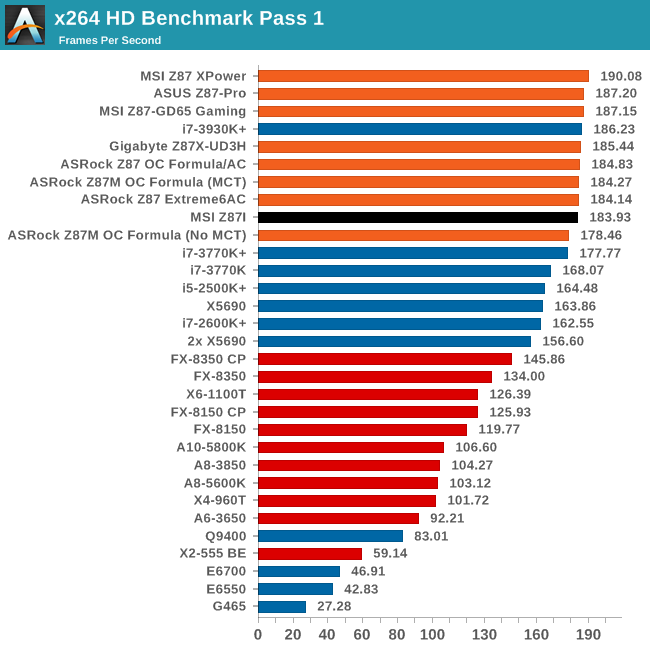

The x264 results propagate the XVC and PovRay results, showing a performance better than true stock but lower than true MCT.
Grid Solvers - Explicit Finite Difference
For any grid of regular nodes, the simplest way to calculate the next time step is to use the values of those around it. This makes for easy mathematics and parallel simulation, as each node calculated is only dependent on the previous time step, not the nodes around it on the current calculated time step. By choosing a regular grid, we reduce the levels of memory access required for irregular grids. We test both 2D and 3D explicit finite difference simulations with 2n nodes in each dimension, using OpenMP as the threading operator in single precision. The grid is isotropic and the boundary conditions are sinks. Values are floating point, with memory cache sizes and speeds playing a part in the overall score.
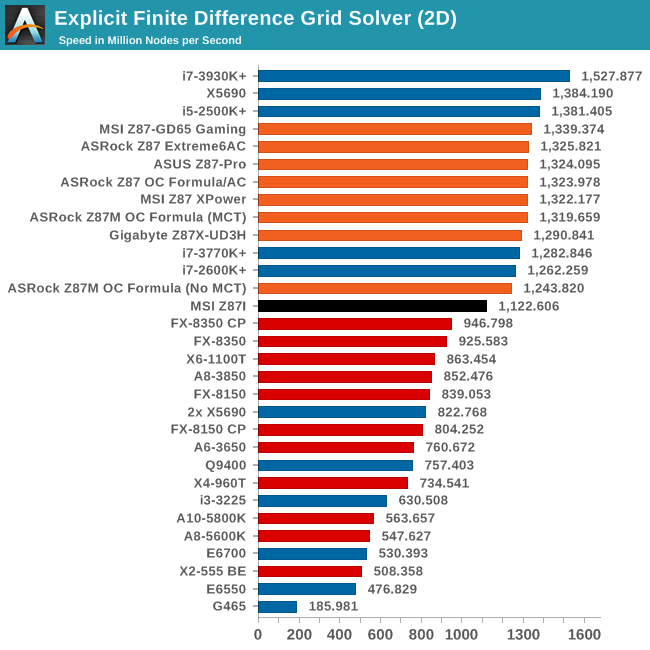
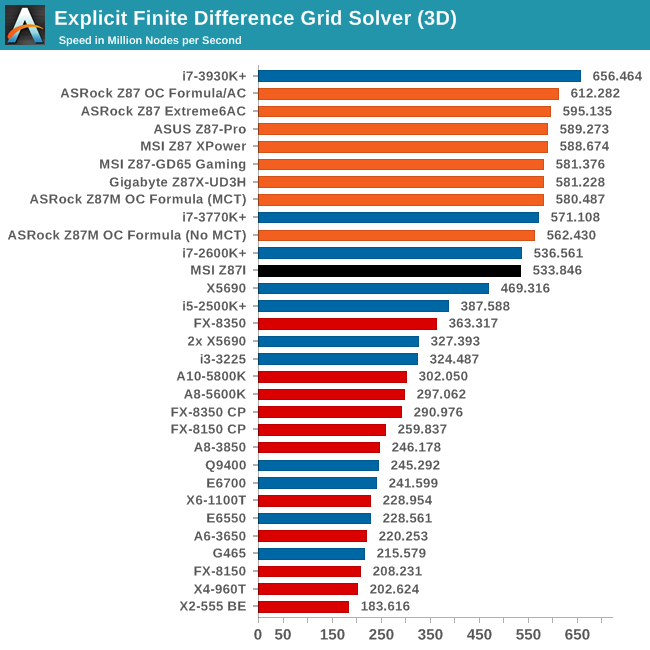
The biggest variance in results comes from our 2D explicit solver result, where the Z87I scores 1122 Mnps compared to 1300+ from MCT enabled motherboards. This result was consistent across reboots and other memory configurations, suggesting a fundamental issue. Though this should not cause a scare for owners of this board – this is the only benchmark I found to produce this result, and thus seems like an edge case. In the 3D variant we are still down, by 8% this time, rather than the 15% observed in 2D.
Grid Solvers - Implicit Finite Difference + Alternating Direction Implicit Method
The implicit method takes a different approach to the explicit method – instead of considering one unknown in the new time step to be calculated from known elements in the previous time step, we consider that an old point can influence several new points by way of simultaneous equations. This adds to the complexity of the simulation – the grid of nodes is solved as a series of rows and columns rather than points, reducing the parallel nature of the simulation by a dimension and drastically increasing the memory requirements of each thread. The upside, as noted above, is the less stringent stability rules related to time steps and grid spacing. For this we simulate a 2D grid of 2n nodes in each dimension, using OpenMP in single precision. Again our grid is isotropic with the boundaries acting as sinks. Values are floating point, with memory cache sizes and speeds playing a part in the overall score.
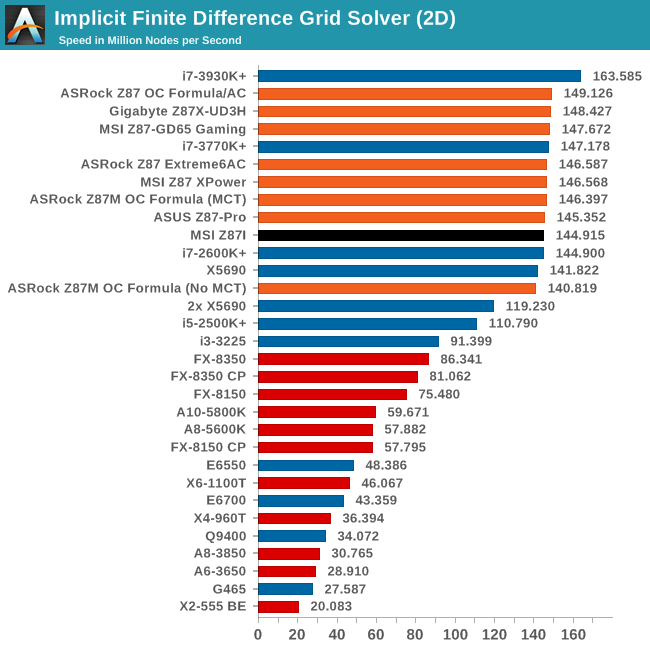
Nothing particularly bad about the Implicit grid solver result from the Z87I, keeping up with the MCT-enabled group.
Point Calculations - n-Body Simulation
When a series of heavy mass elements are in space, they interact with each other through the force of gravity. Thus when a star cluster forms, the interaction of every large mass with every other large mass defines the speed at which these elements approach each other. When dealing with millions and billions of stars on such a large scale, the movement of each of these stars can be simulated through the physical theorems that describe the interactions. The benchmark detects whether the processor is SSE2 or SSE4 capable, and implements the relative code. We run a simulation of 10240 particles of equal mass - the output for this code is in terms of GFLOPs, and the result recorded was the peak GFLOPs value.
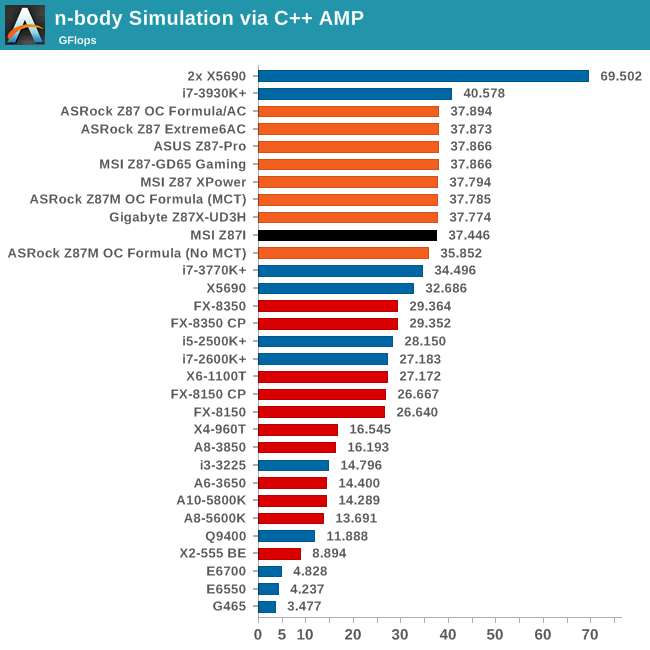
The n-Body result shows that the motherboard is clearly behind the MCT enabled group of motherboards we have already tested, although not too far in this SSE4 enabled benchmark.










46 Comments
View All Comments
kwrzesien - Tuesday, August 27, 2013 - link
I'm confused by their choice of cheap wifi and dual Realtec NICs. So can the wifi board be removed and replaced with mSATA SSD? For example for a wired HTPC setup? Is it easy to find replacement mimo or 802.11ac board?Meaker10 - Tuesday, August 27, 2013 - link
Yes it's the same slot notebooks use so you can get any chipset you want from the kilker 1202 t9 theintek 7260ac. They are also pretty cheap to pick up.fritodorito - Wednesday, August 28, 2013 - link
How well will the 2.4 GHz antennas work for the 5 GHz band?DMisner - Tuesday, August 27, 2013 - link
The wifi board is mini pci-e, not msatabobbozzo - Tuesday, August 27, 2013 - link
No one said otherwise.mSATA SSD's typically go into mini PCIe slots.
Meaker10 - Tuesday, August 27, 2013 - link
Incorrect. While msata and mini pci-e are the same physically they are not electrically compatible so a slot can be designed to either take a mini pcie card or msata but can't take the other.chubbypanda - Tuesday, August 27, 2013 - link
Just to make it clear: mSATA and mini PCIe are indeed electrically compatible.Samus - Wednesday, August 28, 2013 - link
I think they could cram a lot more onto these boards (like another mPCIe slot) if they shrunk the socket area and forced you to use water cooling, something most people buying this board are likely to do anyway.1Angelreloaded - Thursday, August 29, 2013 - link
I like the vertical design Asus chose, If you can't build out why not up.Hrel - Tuesday, September 3, 2013 - link
Water cooling is stupid.